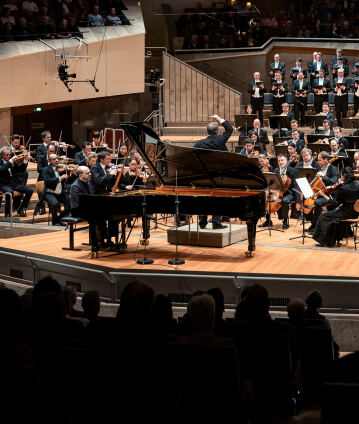Sakari Oramo and Kirill Gerstein

In his Nocturnes, Claude Debussy paints Impressionistic mood pictures: the shades of a cloudy sky, a nocturnal festival and the legendary song of the sirens. The programme also includes Ferruccio Busoni’s sonorous Piano Concerto. It builds a bridge from the Romantic period to the modern era and pushes the boundaries of the genre with its use of a male choir. Under the baton of Sakari Oramo, Kirill Gerstein plays the breathtaking solo part.
Ferruccio Busoni’s Piano Concerto is probably the most impressive concerto in the classical repertoire. The work, which is unusual thanks to its choral finale, is technically extremely demanding. Busoni himself can be regarded as one of the greatest piano virtuosos of all time, and in his concerto, he showcased everything that was possible on the piano: huge chord clusters, high-speed runs and dizzying solo interludes, but also delicate trills and poetic reveries. In fact, the pianistic intricacies of this score put any Rachmaninoff concerto in the shade – which is why Busoni naturally sat at the piano himself at the premiere of his “Skyscraper Concerto”, as he called it, performed by the Berliner Philharmoniker in 1904.
In contrast, Claude Debussy’s Nocturnes, which were inspired by the works of the American painter James McNeill Whistler, thrive on the art of suggestion: His paintings from the 1870s, entitled Nocturnes, depict melancholy, often almost monochrome water views of large cities at night, evoking the atmosphere of a mysterious nocturnal world with delicate matching colours and shifting contours. Since Debussy knew that the work – not a symphony, not a symphonic poem and not a concerto – would puzzle his audience, he wrote a commentary on the third piece, which includes a female choral section: “Sirènes: this is the sea and its infinite rhythm; then the mysterious song of the sirens resounds, laughs and fades from the silvered moonlit waves”.
© 2024 Berlin Phil Media GmbH
Related interviews